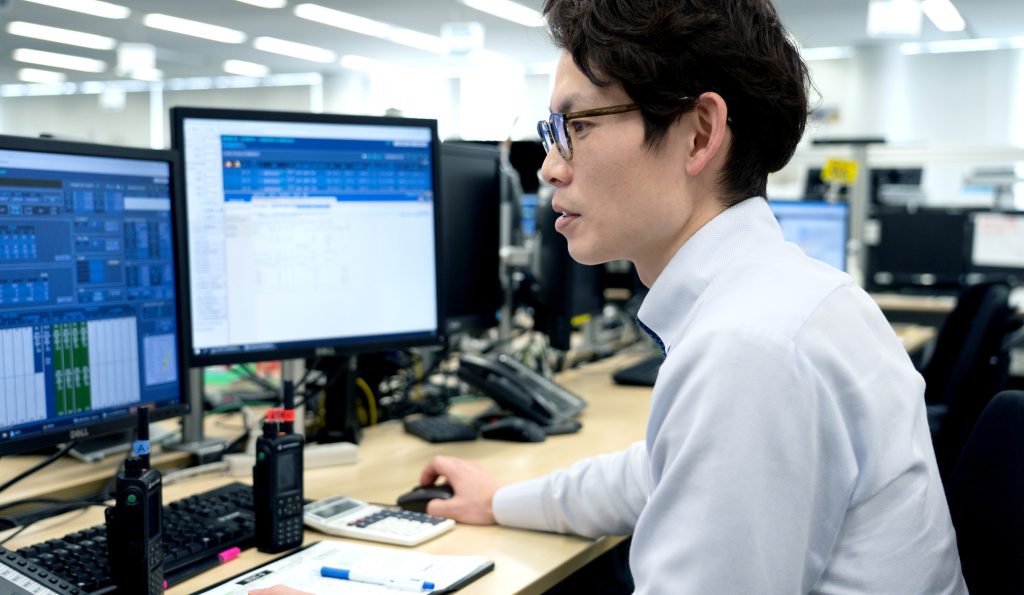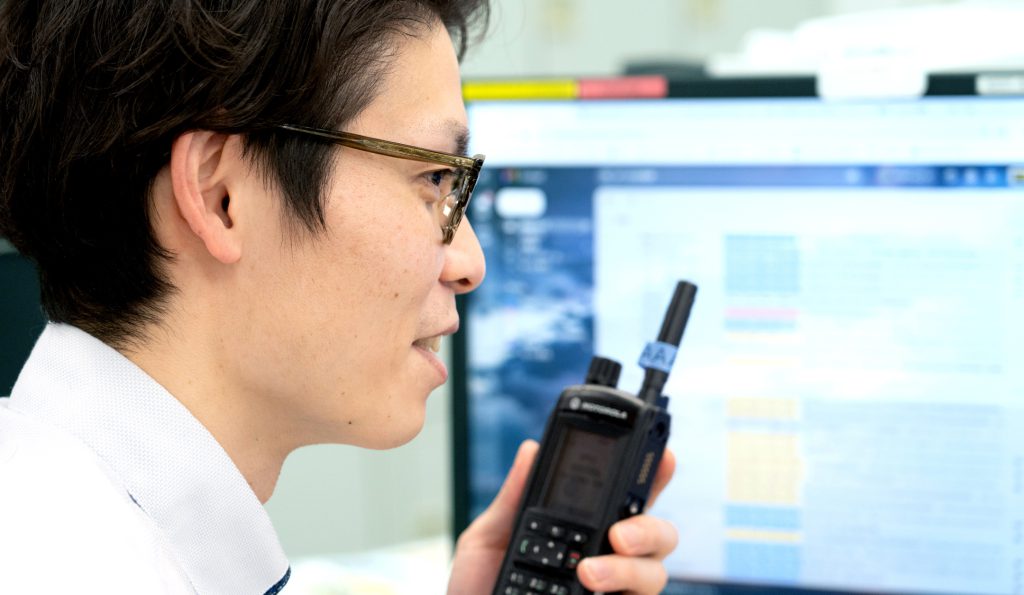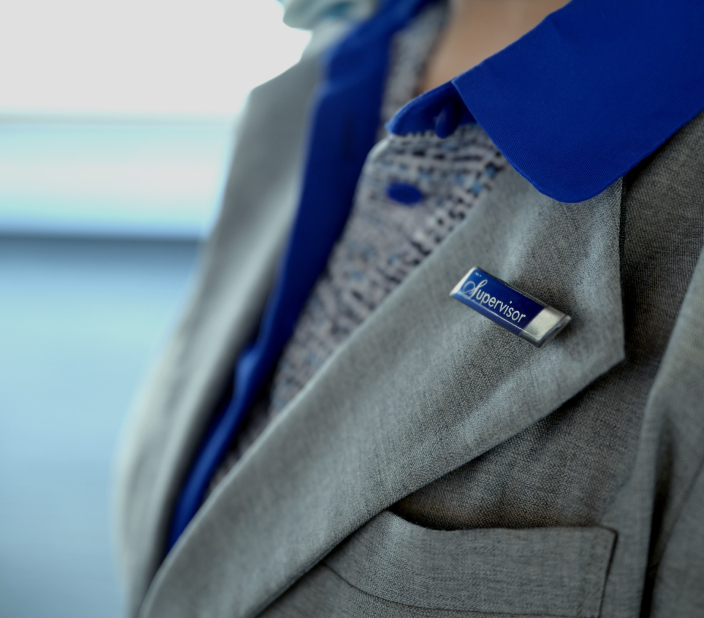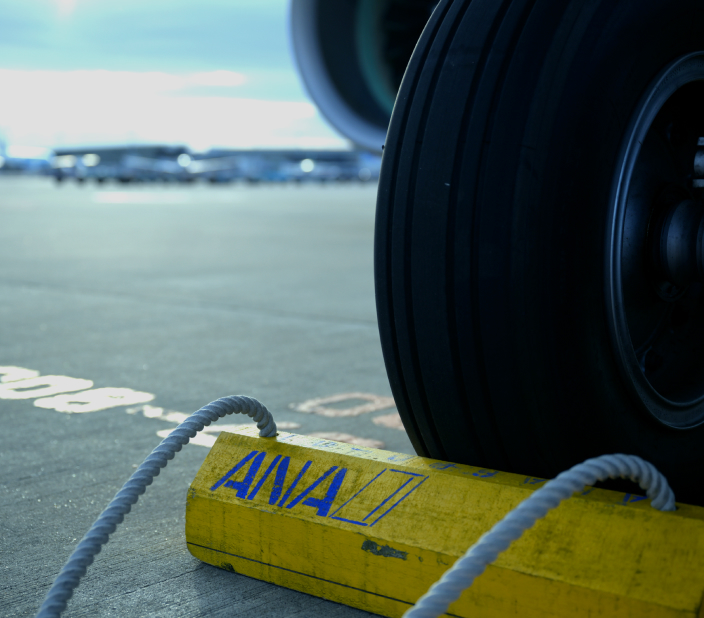Steadfastly supporting
one flight’s safety in the air.
Toshiki Kato
Joined NRTAS in 2013
- Ground Handling
- Operations Management
- New graduate recruiting


From my desired job as a ground handler
to a new challenge as a load controller.
My high school life ended with a graduation trip. As I looked out the window of the aircraft, I saw ground handlers working nearby. They looked so impressive, and I starting thinking that I wanted to work in an airport and work in ground handling. I had already received an unofficial job offer from a company in the steel industry then, but I declined the offer and decided to go to a technical aviation college after high school.
After joining NRTAS, I worked in the Ground Services Division for 10 years. I gained experience in baggage and cargo loading and unloading and pushback and towing operations, and then I transferred to the Operations Management Division, where I knew I wanted to work at some point.
In the Operations Management Division, there are the roles of handling control, where you manage the work time and progress of operations for aircraft from the time it arrives until the time it leaves, and spot control, where you manage the apron in an optimum state. Currently, I perform the role of load control.

Masterfully coordinating aircraft weight balance
for safe flights.
Load control ensures that an aircraft’s maximum weight at which it is able to fly is not exceeded while adjusting the weight and balance (center of gravity), including the customers, baggage, cargo, fuel and so on, to allow the aircraft to depart in an optimum state for a safe flight.
I therefore work closely with the load master in the Ground Services Division, who handles loading and unloading of baggage and cargo, and the different sections of ANA Cargo. I create the plan and give instructions for what baggage and cargo will be loaded where. When it comes to cargo loading, however, there is more than weight that has to be considered. For example, when loading dry ice, it can’t be loaded near dogs and cats and other pets. Cargo with magnetic properties could interfere with flying if placed near the cockpit, so they must be loaded at the back of the aircraft. It is quite difficult to adjust the weight based on these and other various rules.

The satisfaction of having an aircraft fly
according to the plan I made.
The weight of customers’ baggage is finalized 40 minutes before departure. Behind the scenes, the load master and the loading staff start loading operations one hour before departure. If there is less baggage than expected, additional cargo is loaded, and conversely, if there is more baggage than expected, cargo that had been scheduled for loading is unloaded. This delicate dance continues until the last moment. Load control is truly like solving a difficult puzzle in a short amount of time. During the bank time when there is a lot of flight traffic, I can be adjusting weight for four flights at the same time. It requires a level of information processing that feels like it might make smoke come out of your head.
In addition to ANA flights departing from Narita, I can also perform Load Control operations for flights of foreign airlines that are headed to Narita and Haneda from overseas. In this case, I adjust the load distribution of the aircraft remotely, such as sending the loading plan while communicating with the staff using a chat tool.
For about the first two months, I spent every day just trying my best to remember what I need to do for my work duties. It was completely unlike the work I did in the Ground Services Department, where I had to physically use my body. After about six months had passed since being assigned to the Operations Management Division, I was finally able to perform load control for four flights a day. Moments when I feel a sense of reward are when I see an aircraft that has been loaded using a plan that I devised actually take off. I think this work is suited to people who like to run simulations in their head and who love to solve puzzles.

Aiming to reach the position
of making the final decisions for flight operations.
My ultimate goal is to become the Airport Management Officer (AMO), and I’m studying to acquire the various qualifications for this. The AMO is the leader of airport operations. Behind them is the Airport Management Director, which is the dedicated deputy position for airport management. Led by these two people, the ultimate decisions for the day’s flight operations are made.
I want to continue steadfastly carrying out my daily duties, with the aspiration to understand the full picture of airport handling and Narita Airport and provide even better service to customers from that viewpoint as the AMO.

Fulfilling environment
for both work and private life.
You can definitely take your paid vacation at NRTAS, and I’m especially grateful for the strong benefits. There are also a lot of restaurants and large shopping and commercial facilities, with a lot of shops that are easy on your wallet. This helps my household budget. Coworkers that like the outdoors enjoy surfing and camping. I recommend working at NRTAS for people who not only want to feel a sense of fulfillment at work but also want to have a fulfilling private life with strong benefits.

Day
Schedule
-
15:00
Assigned flight support
I perform load control operations for three flights at the same time during the bank of flights. -
18:30
Break
During my break, I have a coworker cover my waiting flights.
-
19:30
Assigned flight support
I perform load control operations for my remaining flights, which are going to Haneda.
-
20:30
Attend a meeting
Staff from each section get together, review the day’s flights and share the topics for the next day.
-
21:00
Preparations for the next day
I make container adjustment and weight requests in advance for the next day’s flights.
-
22:30
Finish work
I attend the end-of-day meeting and finish my work.

Places
My favorite parts of Narita
-

Koi fish swim in the pond of the P1 parking lot. This is where I meet my family after work, and my children love to watch the koi fish.
-

The Museum of Aeronautical Sciences store is located on the fifth floor of the terminal. I love to buy souvenirs and calendars for friends here.
-

The vertical tail of an ANA aircraft against the sky.


Leading ANA’s international flight operations, NRTAS is aiming for new heights.
NRTAS will create the new era.










